Each year, February and March offers international observations that honor women for their vast contributions to science and society with the International Day for Women and Girls in Science; Women’s History Month and the International Women’s Day.
To celebrate these important observations, we connected with the college’s women faculty and alumnae who have taken hold of their passion for optical sciences and are living out their dreams. The Wyant College Women in Research will be an annual feature every February and March.
2023 Women in Research
Women in Research - Alumna & Faculty
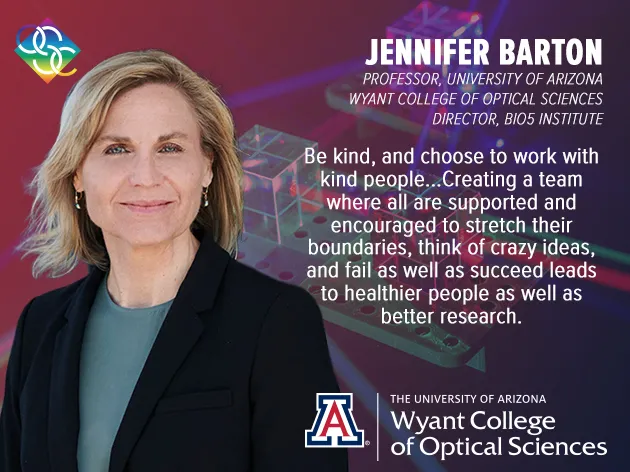
Describe your Research Contributions or Interests.
I work at the interface of biology, engineering, medicine, and optics to develop multimodal miniature endoscopes for early cancer detection. These endoscopes go beyond the currently-available white light surface imaging to obtain additional information about tissue health, through advanced optical imaging techniques such as optical coherence tomography, fluorescence spectroscopy, and multiphoton microscopy. Using the latest in technology developments (robust portable lasers, miniature sensors, capable fiber optics) as well as the latest in knowledge of the biological origin of cancer, my lab is focused on creating clinically-translatable devices. Working with physicians, biologists, and industry partners, we aim to create systems that can find abnormal tissue early, when cancer is most treatable. Our miniature endoscopes, some less than a millimeter in diameter, can examine organs deep in the body in a minimally-invasive manner. With this technology, our goal is to relieve the burden of cancer, particularly ovarian cancer, which is the most deadly gynecological malignancy.
Who was your Most Significant Role Model in Science or in your Career?
My parents had a huge impact on my career. I was fortunate that they both believed in me and expected me to become an engineer just like my brothers. My father taught me how to wire a house and my mother tutored me in calculus when I was struggling. My father was the Chief Engineer on the Apollo 11 Command Module and my mother was a NASA Computer, and after a pause to have 5 children, worked on Space Shuttle projects. They both had very high expectations for me which could be challenging, but gave abundant support as well.
What Piece of Advice Would you Like to Pass On?
Be kind, and choose to work with kind people. Over the years I've realized that human beings have enormous potential that can be brought out by kindness. Creating a team where all are supported and encouraged to stretch their boundaries, think of crazy ideas, and fail as well as succeed leads to healthier people as well as better research.
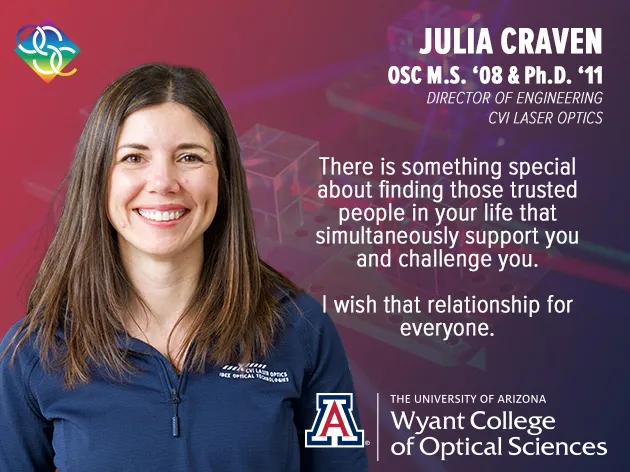
Describe your Research Contributions or Interests.
I am honored and humbled to serve as the Director of Engineering at CVI Laser Optics. My most important work is to enable and empower the CVI Engineering Team to bring their best contributions to their work every day. There are many facets to this work, from direct one-on-one conversations with engineers and those that they serve, to championing and obtaining support for the strategic technical needs and capabilities that will make us successful for years to come. When I do this work well, I feel incredibly energized by my ability to be a force multiplier.
I also still get to go roll up my sleeves and contribute in our R&D laser lab (The CVI Spectra Rays Laser Lab!) on the regular, and I especially love these experiences when I can bring someone along with me to learn and grow their technical skills.
Who was your Most Significant Role Model in Science or in your Career?
Most significant is so difficult! I have been fortunate to have many excellent role models. I’m going to approach this question a little differently and call out Katie Schwertz (Edmund Optics) and Krisinda Plenkovich (Free Range, formerly with SPIE). The three of us worked together regularly a few years back, and our 3-person team was a defining collaboration for me in terms of growing me into a passionate, action-oriented leader. Krisinda is more professionally experienced than Katie or me, so she was for me more of the role model from that perspective, but simultaneously having a peer in Katie has always been particularly valuable. There is something special about finding those trusted people in your life that simultaneously support you and challenge you. I wish that relationship for everyone.
What Piece of Advice Would you Like to Pass On?
Just one?!
One of the best perspectives I have ever received was about sticking to the facts versus telling a story that connects between the facts. For example, say this happened to you: Person X, someone you work with, didn’t come to your meeting, and then the next day they didn’t respond to your email, and two days later when you passed them in the hall they didn’t even smile at you. That could lead you to tell a story that Person X is not a team player and has some personal issue with you. But guess what – that’s a total story! Maybe Person X has something going on that has nothing to do with you, and you have zero clue about! Don’t put your emphasis and energy on the story - which may be completely false – instead go talk to Person X, with kindness, about the facts.
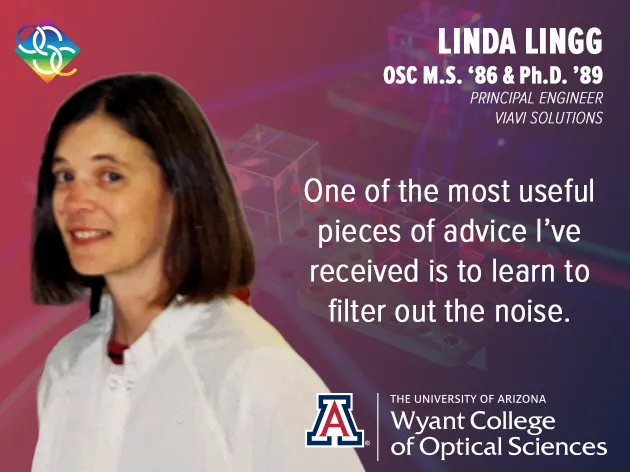
Describe your Research Contributions or Interests.
My research and subsequent applied work are mainly in the field of optical thin film materials and interference coatings. I began looking at the microstructure, stoichiometry, and optical properties of Lanthanide Fluoride thin films while at the Optical Sciences Center. There the application was for Vacuum Ultraviolet optical systems, but these materials are used today throughout the spectrum due to their wide transparency range.
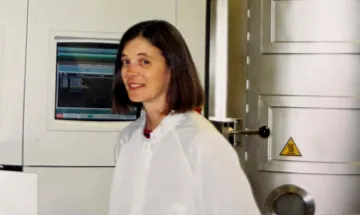
Linda Lingg with optical coating equipment
That project led to further fluoride work characterizing CVD deposition precursors for sodium fluoride, a component of low optical loss ZBLAN fluoride glass intended for fiber communication. As internet demand grew, I worked on the Optical Monitoring, design and deposition of telecom Narrow Band Filters. For the last 20 years I have been designing and developing specialized, high-tech interference coatings and components for space exploration, ground-based telescopes, laser surgery, world-wide laser programs and sensing.
Who was your Most Significant Role Model in Science or in your Career?
Angus Macleod and Gary DeBell have been role models for me.
What Piece of Advice Would you Like to Pass On?
One of the most useful pieces of advice I’ve received is to learn to filter out the noise.
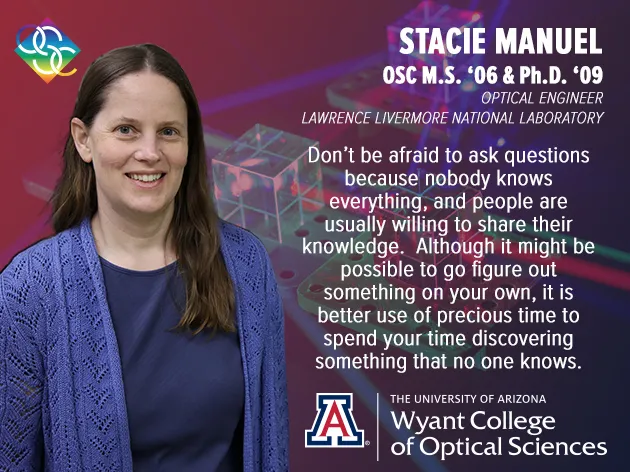
Describe your Research Contributions or Interests.
I am an optical engineer at Lawrence Livermore National Laboratory. Since receiving my PhD from Arizona, I have contributed to many projects throughout LLNL. I have spent most of my career at the National Ignition Facility (NIF), the world’s most energetic laser and I am so excited about the recent historic accomplishment of achieving fusion ignition in a laboratory setting. As a member of NIF’s Optical Design and Engineering group, I had the opportunity to contribute to many optical target diagnostic systems, such as the Optical Thomson Scattering (OTS) diagnostic and the Velocity Interferometer System for Any Reflector (VISAR).
Currently, I am working in the High Explosives Applications Facility (HEAF) to upgrade a high-speed imaging system called High Explosives Laser Imaging Optical System (HELIOS) to be multi-axis. HELIOS uses a femtosecond laser to create a supercontinuum source for illumination with high-speed, high-resolution framing cameras to enable multi-frame imaging of initiators and detonators in motion.
In addition, whenever possible I share my love of optics in outreach activities such as Expanding Your Horizons and most recently LLNL’s restarted Fun with Science Program, where 5th graders visit LLNL’s Discovery Center on field trips.
Who was your Most Significant Role Model in Science or in your Career?
My most significant role model has been Jim Burge, my PhD advisor. Jim shared his passion for optics with his students and always made it a point to understand the big picture. As leader, he provided opportunities for students to learn from different types of projects and promoted group members (including himself) to learn from each other. For example, when he didn’t know the answer to a question, he often encouraged us to “Go find out and let me know.” It was a privilege to work with him and I am grateful for everything he taught me about optical engineering.
What Piece of Advice Would you Like to Pass On?
Don’t be afraid to ask questions because nobody knows everything, and people are usually willing to share their knowledge. Although it might be possible to go figure out something on your own, it is better use of precious time to spend your time discovering something that no one knows.
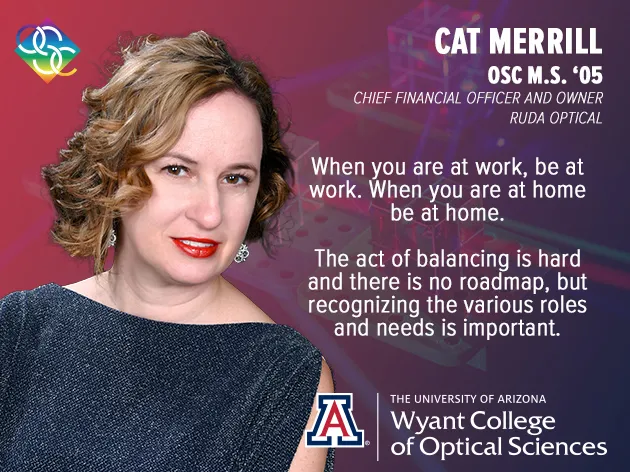
Describe your Research Contributions or Interests.
My work is in the field of Optics. Historically, I build and deliver first generation hardware. I have been very lucky to work in many aspects of that field: radiometric and spectral calibration, image processing, system requirements development, algorithm development, and program management. I have worked in missile defense (EKV and SM-3), space research (OSIRIS-Rex), ground based telescopes (Giant Magellan Telescope), community science (NOIR Labs Community Science and Data Center). I was even fortunate enough to mentor at The College of Engineering as part of Engineering 498. I developed an agile development version of the program. I am now the co-owner of Ruda Optical. Ruda is a custom optical design and analysis firm here in Tucson. We design, analyze, build, align, and test systems per our customer’s needs. At Ruda, as Chief Financial Officer and Director of Programs, I run the Program Management Office and Business Office. I am a point of contact for all customers. I oversee the cost, schedule, risk, and technical management of all programs within Ruda.
Who was your Most Significant Role Model in Science or in your Career?
Dr. Kent Pflibsen. He taught me to ask better questions and that hard work is recognized. He guided me into an advanced degree that resonated with me and was also useful to him and to Raytheon. I look at him and his body of work, and I am humbled that he always (and I mean always) made time for young engineers who were willing to learn and work. I thank him every day for my career.
What Piece of Advice Would you Like to Pass On?
When you are at work, be at work. When you are at home be at home. We all struggle with the work life balance. Sometimes the personal stuff takes over and you need to pay attention to that. Sometimes work is more demanding. It is important to identify all your needs and responsibilities and recognize that they each have a time and place. Sometimes the priorities switch for periods of time. This happens. But recognizing when you cannot be at work because other life needs you is important. Likewise, when you need to spend the extra time to support your team, the family side needs to be flexible. You do not want both your work life and home life to be in crisis at the same time! The act of balancing is hard and there is no roadmap, but recognizing the various roles and needs is important.
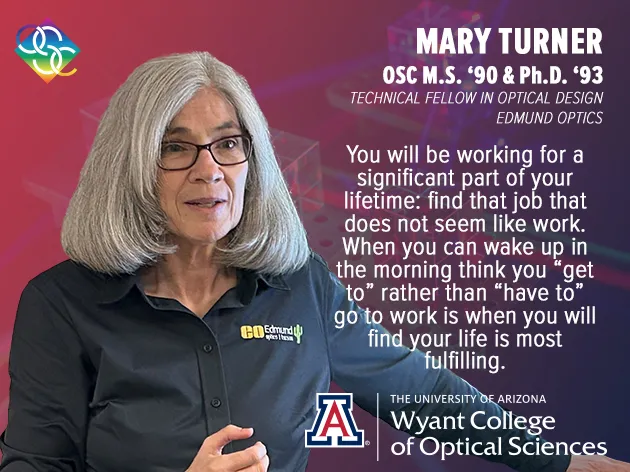
Describe your Research Contributions or Interests.
My role as Technical Fellow in Optical Design at Edmund Optics has three main branches. I spend most of my time working as on optical designer. I also dedicate time mentoring junior designers in various aspects of the craft. In this vein, I am provided the freedom to serve as an Adjunct at Optical Sciences, lecturing each year on subjects relating to optical design. Additionally, I have a role within the company to look at new and upcoming technologies and analyzing the possible benefit to Edmund of these technologies.
Working on optical design projects at Edmund provides an amazing opportunity to use and enhance my skills as a designer and engineer. We all know that “optics is an enabling technology”. Much of my design work is based on this adage. Many companies are working on products that require optics, but the optics are not the primary aspect of the product. For many of these companies, it is not possible or cost effective to develop or manufacture the optical subassemblies in-house. For many of these companies, working with Edmund to design and supply the optics is the best solution. This provides me, as well as our other designers, the opportunity to work on many different design projects, covering a wide array of optical spaces from classical imaging systems for machine vision applications, imaging and non-imaging designs for laser applications, various systems on the path to autonomous driving, as well as telecommunications devices.
Who was your Most Significant Role Model in Science or in your Career?
It might sound “old fashioned”, but my most significant role model was my mother. As an elementary school teacher, she instilled the love of teaching that has been an integral part of my career. She grew up in an era where women were dissuaded from entering careers in the sciences or technology and she was instrumental in my realization that I could explore a career in engineering, all I needed was the drive and desire to succeed.
What Piece of Advice Would you Like to Pass On?
You will be working for a significant part of your lifetime: find that job that does not seem like work. When you can wake up in the morning think you “get to” rather than “have to” go to work is when you will find your life is most fulfilling. And remember, if your goals or your work environment changes, you are always able to reevaluate and make career changes.
2022 Women in Research
Women in Research - Alumna & Faculty
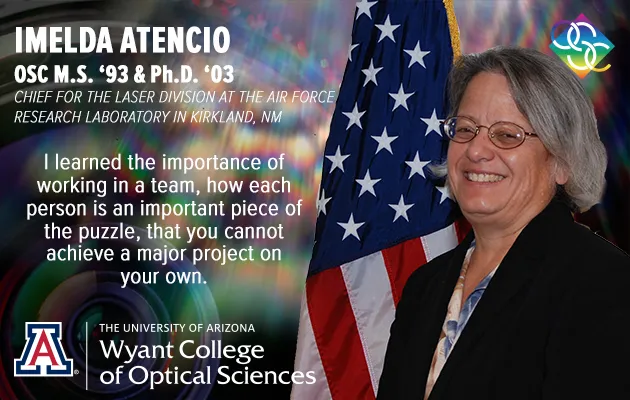
Describe your Research Contributions or Interests.
My dream growing up was to be an astronomer, sitting on a mountain top with ‘my’ telescopes. Turned out astronomer’s instruments, i.e., telescopes, became my passion and by extension optical design. During my 35-years at the Air Force Research Lab (AFRL) I have worked and filled many roles. I started out as a FORTRAN programmer developing computer code in the area of imaging techniques applied to high resolution images of space objects.
I gained an opportunity to attend graduate school at the UA Optical Science Center via an AFRL program and received my MS in 1993. The next 19 years of my career at AFRL, I worked as an Optical Engineer at the Starfire Optical Range, a large telescope facility known for world class research in adaptive optics. This included work in optical design and research in various aspects of adaptive optics technology including multi-conjugate multi beacon adaptive optics and optical communications.
While working, I completed my Ph.D. in absentia from UA in 2003. In the latter part of my career, I worked on facilitating collaborations between AFRL scientists and engineers and industry and academia, eventually becoming a supervisor, and recently named Chief for the Laser Division. I now lead a team conducting research in advanced laser technologies, including multiple laser source research (fiber, solid state, and semi-conductor), laser effects, atmospheric turbulence/aero-effects mitigation, and laser system demonstrations.
Who was your Most Significant Role Model in Science or in your Career?
I have had 2 significant role models in my career, Dr. Janet Fender and Dr. Robert Fugate.
Dr. Fender was the first Ph.D. female scientist I met, who taught me what it meant to take care of her employees. Not only did she encourage and open up opportunities, but also when I was going through a rough period in my life, she took me in. She guided me through the government process which paid my way to graduate school.
Dr. Fugate fulfilled my life-long dream of working on a mountain top with ‘my’ telescopes, providing a path for me to complete my dissertation in absentia and impressed upon me leadership skills I use to this day. He saw the gifts and talents in people putting them in appropriate positions, allowing them to excel, but be accountable. I learned the importance of working in a team, how each person is an important piece of the puzzle, that you cannot achieve a major project on your own.
What Piece of Advice Would you Like to Pass On?
Follow your dreams, persevere, collaborate, and seek out good mentors/leaders along the way to observe, follow, and learn from.
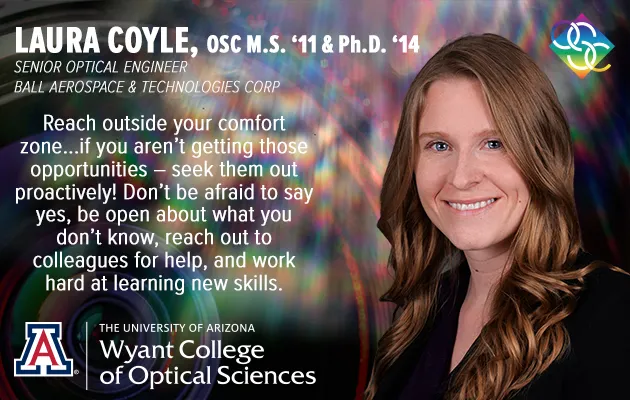
Describe your Research Contributions or Interests.
I am an Optical Engineer at Ball Aerospace where I help design, build and test optical systems for space-based applications spanning nascent research and development efforts to decades-long flight programs. My background in optical alignment and metrology led to roles on the Operational Land Imager 2 (OLI-2) instrument for the Landsat 9 mission, where I supported the fabrication, alignment and performance testing of 4 mirror telescope, and the James Webb Space Telescope, where I am a member of the ground testing and on-orbit commissioning team as a Wavefront Scientist.
In addition to executing flight programs, I serve as the Technology Initiative Lead for Astrophysics. In this role, I work closely with our business development team to identify opportunities to develop approaches and technologies that will enable future Astrophysics missions at a variety of scales. One particularly exciting program I’m leading - called “ULTRA” –supports direct imaging of potentially habitable exoplanets with a high contrast coronagraph. Achieving the necessary 10-billion-to-one contrast to observe a rocky planet next to its host star requires optical wavefront stability on the order of picometers – which requires a telescope with stability orders of magnitude beyond the state of the art. I’m leading a team of industry and academic partners to develop new technologies to realize that level of stability, including Ball-developed edge sensors and actuators that can control the rigid body motions of a segmented primary mirror at the picometer level.
Who was your Most Significant Role Model in Science or in your Career?
My primary role models have always been those closest to me. It began with my Mom and Dad, who always ensured my elementary and middle school science fair projects were physics-themed and actually followed the scientific method. They asked what I thought would happen to the period of pendulum when I increased the weight, took me to Home Depot to buy washers and string, and watched me convert the frame of a My Little Pony tent into a pendulum experiment station – and lo and behold, I discovered that the period doesn’t change! I’ve also had several outstanding mentors in graduate school, notably Jim Burge and Matt Dubin, and at my current employer, Ball Aerospace, who have inspired my career trajectory. One of the things I’ve admired most in these mentors, in addition to their extensive technical knowledge, is their ability to understand the big picture and ask the right question. Engineers often don’t know the right answer right off the bat (or it wouldn’t be a very interesting profession!), but if you can ask a key question and figure out what matters, you are well on your way to solving hard problems.
What Piece of Advice Would you Like to Pass On?
Reach outside your comfort zone. In your career, there will likely be times when you are asked to take on an assignment that stretches beyond your capabilities (and if you aren’t getting those opportunities – seek them out proactively!). Those opportunities can be intimidating but are often the most valuable for growth. Don’t be afraid to say yes, be open about what you don’t know, reach out to colleagues for help, and work hard at learning new skills. That said, there is more to life than work so don’t take on so much that you can’t achieve a balance that works for you.
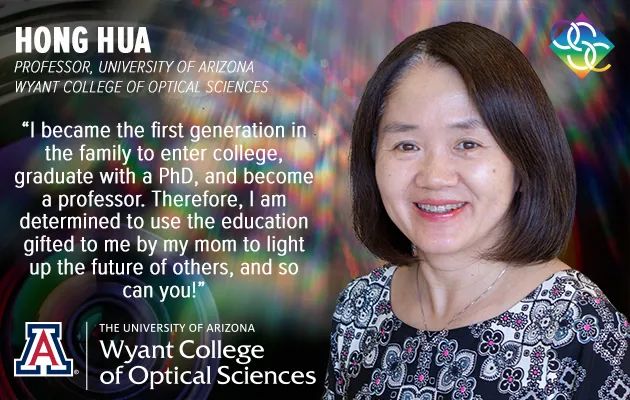
Describe your Research Contributions or Interests.
My research at the Wyant College of Optical Sciences mainly focuses on developing optical technologies for 3D displays, especially head-worn display technologies for virtual and augmented reality (VR/AR) applications, and microscopic and endoscopic imaging technologies for medicine. In the area of wearable display technologies, my group has been working on a wide range of the cutting-edge optical technologies to address some of the most challenging problems in VR/AR displays such as minimizing visual fatigue induced by vergence-accommodation conflicts and accurately rendering mutual occlusion cues between virtual and physical objects.
Besides these enabling optical technologies, we have also been developing wearable display technologies for a wide range of applications from defense industry to assistive technology for users with disabilities; and scientifically investigate the potentially negative impacts of the state-of-art 3D display technologies on visual perception, visual comfort, and even long-term vision health of users. One example of the wearable display technologies we developed is the eSight 3 product, an advanced assistive eyewear technology enabling people with central vision loss or poor vision in general to be able to see better their surroundings, improve their mobility, and live more independently. Closely collaborating with the team from eSight, a Canadian based startup company, my group led the development of a unique freeform eyepiece optics from concept design, optics optimization and prototype, to optics molding support for volume production. In the area of biomedical imaging, we have been developing novel endoscopy and microscopy technologies for minimally invasive surgery. We collaborate with surgeons to develop endoscopes that provide novel imaging capabilities to address some of the critical issues with the state-of-the art laparoscopic technologies such as lack of spatial awareness, safety, efficiency, and 3D imaging.
Who was your Most Significant Role Model in Science or in your Career?
Many people made significant impacts in my career development. Among those, Dr. Yongtian Wang, my Ph.D. advisor, was truly my role model and mentor. Prof. Wang’s genuine inspiration and curiosity deeply planted the seeds of innovation inside me, and his rigorous scholarship as well as his patience and kind support to his students have become the example I have been trying to follow in my academic career.
What Piece of Advice Would you Like to Pass On?
Being rigorous in scholarship and being perseverant in research are what I learned from my mentor and are what I would like to pass to my students.
Other life wisdom:
I grew up in a relatively poor family and lost my dad when I was still very young, but my mom as a middle-school math teacher believed in the power of education. She worked very hard to support me for the best education I could possibly get while she alone endured the financial suffering and hardness. I became the first generation in the family to enter college, graduate with a PhD, and become a professor. Therefore, I am determined to use the education gifted to me by my mom to light up the future of others, and so can you!
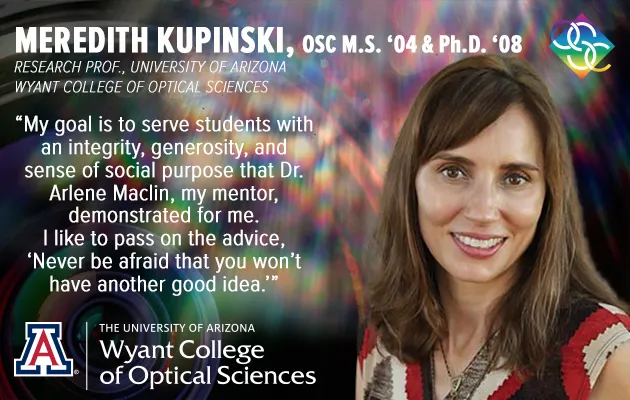
Describe your Research Contributions or Interests.
My Little Sensor Lab currently focuses on the creation and use of ultra-sensitive optical sensors for fundamental science, translational medicine, and environmental monitoring. We work on both improving the sensor technology (e.g., enhancing our sensors with plasmonics and incorporating frequency comb spectroscopy) as well as applying the technology to societally important problems such as Alzheimer's disease, cancer, infectious disease, chemical threat sensing, and doping in athletics. The research group currently consists of 8 Ph.D. students. I serve as the PI for an NIH R35 MIRA grant as well as PI for a Defense Threat Reduction Agency (DTRA) grant. I’m also the PI of a grant with Cargill on taste receptors. In addition, I am the PI of two Scialog Fellows Chemical Machinery of the Cell Research Collaboration grants, one of which just ended. Previously, I have been the PI of an NSF project on developing a new molecular spectroscopy system as well as a Partnership for Clean Competition Grant on trace detection of doping agents in urine. I have also been the PI of an NIH R21 and R03 grant on encapsulating our sensors with G-protein coupled receptors for small molecule detection as well as trace detection of Alzheimer’s biomarkers.
Who was your Most Significant Role Model in Science or in your Career?
I have had many role models growing up. I was inspired to pursue science by my father who is a mechanical engineering professor. As just one example of how he inspired me, when I was in second grade, we were told to make a solar cooker by wrapping a paper plate in aluminum foil. My dad asked me what I was doing. When I explained to him the assignment, he showed me how to use a parabola to focus light. He showed me how to plot a parabolic function on paper and cut many of them out to make a large supporting structure which we covered with aluminum foil. The final solar cooker was immense. I could not get my arms around it. It was the only solar cooker in the class that worked, and I cooked hot dogs for the entire class the next day.
As I grew up, my father also introduced me to many role models. Just to name a few: Gauss, for his maxim with respect to publications: “pauca sed matura” (“few but ripe”), Faraday for his pioneering spirit in discovering new phenomena through experiments, and Confucius for his teaching philosophy: “educate students of all diversity; teach according to their preparation.”
My most recent significant role model nowadays is William A. Goddard III of Caltech. I first knew him as my brother’s Ph.D. advisor and a prominent scientist who is one of the most highly cited living chemists. We talked about science and life during my brother’s wedding a few years ago. His research has been “to describe the properties of chemical, biological, and materials systems directly from first principles (without the necessity of empirical data)”. My sensor work complements his research. We meet twice a week and work together on a variety of projects such as pain control, drug discovery, and understanding how taste and olfaction work. I’ve never met anybody with his work ethic and his optimism. In a recent celebration of serving 50 years as a faculty at Caltech, he commented on planning for 15-20 more years. I hope to be able to stand on the shoulders of such giants for as long as possible.
What Piece of Advice Would you Like to Pass On?
“Only worry about things under your control” is probably the most useful advice I rely on nowadays. This advice allows me to focus on real issues in order to make a difference.
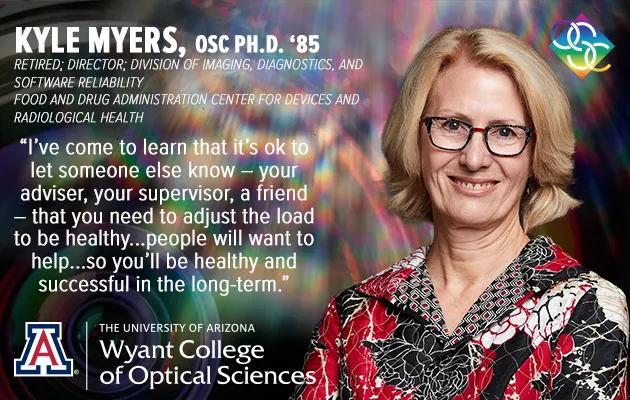
Describe your Research Contributions or Interests.
I recently retired from the US Food and Drug Administration after 30+ years in the research office of the Devices and Radiological Health. Over my career I was engaged in research programs in medical imaging systems and software tools including breast imaging systems and CT devices; digital pathology systems; medical display devices including Augmented Reality/ Virtual Reality systems; Artificial Intelligence, Machine Learning and other computer-aided diagnostics; biomarkers (measures of disease state, risk, prognosis, etc. from images as well as other assays and array technologies), and assessment strategies for imaging and other high-dimensional data sets from medical devices.
My work has been devoted to the development of a rigorous framework for evaluating imaging systems, where rigorous means we don’t base our evaluations on whether the imaging system gives nice-looking pictures, but by actually measuring the information in those images. My research and that of my team provided medical device manufacturers with more predictive pathways to market for their innovative products based on solid scientific evidence of device performance while also providing the regulatory decision-making process with expertise and objective independent data so that regulatory decisions in this country aren’t based on just the company’s data.
Who was your Most Significant Role Model in Science or in your Career?
My most significant role model was Dr. Marcia McBeath. She was the first woman I met with a Ph.D., a woman who obtained her Ph.D. at Stanford in the 1960s at the same time as her husband, while raising 4 young children. Later in her life she and her husband, newly empty nesters at the time, opened their home to me when I needed to leave Mexico and my family for better high schooling in the US. She was a great example of making it all work – a career, marriage, and family. After Marcia and her husband retired from their professional careers they joined the U.S. Peace Corps, eventually being stationed in six foreign countries!
What Piece of Advice Would you Like to Pass On?
I am super grateful for the opportunities I’ve had as a result of my education at the Wyant College of Optical Sciences. I’ve had the opportunity to travel and to meet people who are from all over the world, who are interesting and passionate about what they do, and making an impact on human health. At the same time, getting that degree and working in our field can involve long hours and a lot of pressure. I’ve come to learn that it’s ok to let someone else know – your adviser, your supervisor, a friend – that you need to adjust the load to be healthy. When you communicate that need in a constructive way, most people will want to help make the changes that are needed so you’ll be healthy and successful in the long-term.
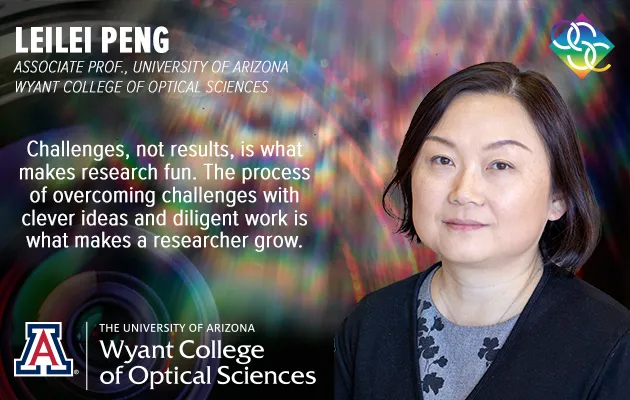
Describe your Research Contributions or Interests.
My lab focuses on inventing new fluorescence microscopy techniques and developing advanced imaging instruments for investigating biological systems. We have established a track record in developing innovative approaches and optical tools to study fast biological processes, including the ability to conceive innovative imaging techniques, build prototype instruments, develop image acquisition software, and apply these techniques to collaborative biological studies. Our work has made high impacts in several imaging technology development areas: high-resolution fluorescence imaging in deep tissue, multiplexed imaging in cells and tissue, and superresolution microscopy. We form close collaborations with bioscience research groups in neuroscience, system biology, developmental biology, and genetics etc. In addition to imaging technique development, we are intimately involved in experimental design, image data analysis, data interpretation, and image result rendering in collaboration with biologists.
Who was your Most Significant Role Model in Science or in your Career?
The most significant role model in my scientific career is my Ph.D. advisor Dr. David D. Nolte. He showed me how to drive research with curiosity, and how to enjoy the journey even when it is filled with failures and frustrations.
What Piece of Advice Would you Like to Pass On?
The advice I want to pass on to women who are interested in a research career is: Challenges, not results, is what makes research fun. The process of overcoming challenges with clever ideas and diligent work is what makes a researcher grow. Results can be frustrating sometimes, but you always learn something in the fight with challenges.
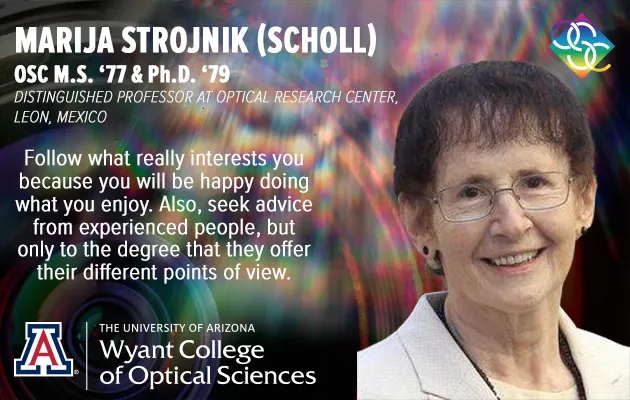
Describe your Research Contributions or Interests.
I use my knowledge of optical sciences, engineering, and infrared technology to solve problems for the benefit of humanity. As a grad student at the University of Arizona, I introduced a remote, non-contact temperature-measurement technique. I developed the theory in support of it, prepared the simulations, and designed several experiments to demonstrate its feasibility. This technique has been routinely used for temperature screening of people during the covid-19 pandemic before entering public buildings and vehicles. At the Caltech’s Jet Propulsion Laboratory, I introduced new mathematical algorithms to identify the smallest non-repeating vector located in a measured stellar field, insensitive to errors. On its basis I developed an optical navigation technique that took the Cassini mission successfully to the outer planets in our solar system.
I am probably best known as a planet hunter. I proposed, and demonstrated in a laboratory experiment, a new, original technique for discovering planets outside our solar system. All the other instruments used today to discover the planets are statistical in nature and use instruments that humanity have been using for at least one century. Telescopes, cameras, spectrometers (used by recipients of the Nobel prize), and radiometers are already highly developed instruments, where we nowadays incorporate ever more sophisticated components. My novel instrument, a rotational shearing interferometer, has the advantage of being able to connect the signal causally to the presence of a planet.
Who was your Most Significant Role Model in Science or in your Career?
I was a dedicated reader. I read many life stories of great discoverers. In the seventh grade I read a book about the atom. Afterwards, I read a book about the electromagnetic theory, that is light. I cannot really say that I ever had a role model, only love and interest of science.
What Piece of Advice Would you Like to Pass On?
Follow what really interests you because you will be happy doing what you enjoy. Also, seek advice from experienced people, but only to the degree that they offer their different points of view.
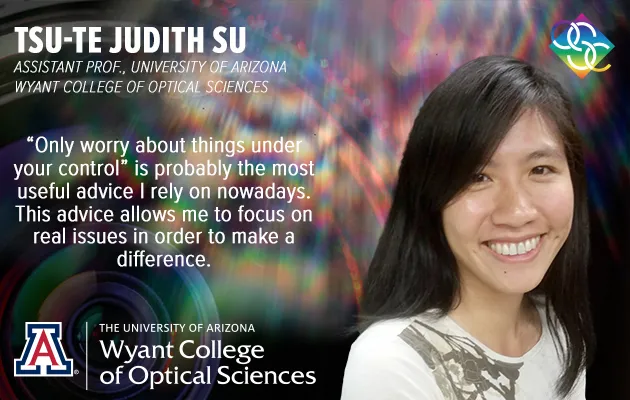
Describe your Research Contributions or Interests.
My Little Sensor Lab currently focuses on the creation and use of ultra-sensitive optical sensors for fundamental science, translational medicine, and environmental monitoring. We work on both improving the sensor technology (e.g., enhancing our sensors with plasmonics and incorporating frequency comb spectroscopy) as well as applying the technology to societally important problems such as Alzheimer's disease, cancer, infectious disease, chemical threat sensing, and doping in athletics. The research group currently consists of 8 Ph.D. students. I serve as the PI for an NIH R35 MIRA grant as well as PI for a Defense Threat Reduction Agency (DTRA) grant. I’m also the PI of a grant with Cargill on taste receptors. In addition, I am the PI of two Scialog Fellows Chemical Machinery of the Cell Research Collaboration grants, one of which just ended. Previously, I have been the PI of an NSF project on developing a new molecular spectroscopy system as well as a Partnership for Clean Competition Grant on trace detection of doping agents in urine. I have also been the PI of an NIH R21 and R03 grant on encapsulating our sensors with G-protein coupled receptors for small molecule detection as well as trace detection of Alzheimer’s biomarkers.
Who was your Most Significant Role Model in Science or in your Career?
I have had many role models growing up. I was inspired to pursue science by my father who is a mechanical engineering professor. As just one example of how he inspired me, when I was in second grade, we were told to make a solar cooker by wrapping a paper plate in aluminum foil. My dad asked me what I was doing. When I explained to him the assignment, he showed me how to use a parabola to focus light. He showed me how to plot a parabolic function on paper and cut many of them out to make a large supporting structure which we covered with aluminum foil. The final solar cooker was immense. I could not get my arms around it. It was the only solar cooker in the class that worked, and I cooked hot dogs for the entire class the next day.
As I grew up, my father also introduced me to many role models. Just to name a few: Gauss, for his maxim with respect to publications: “pauca sed matura” (“few but ripe”), Faraday for his pioneering spirit in discovering new phenomena through experiments, and Confucius for his teaching philosophy: “educate students of all diversity; teach according to their preparation.”
My most recent significant role model nowadays is William A. Goddard III of Caltech. I first knew him as my brother’s Ph.D. advisor and a prominent scientist who is one of the most highly cited living chemists. We talked about science and life during my brother’s wedding a few years ago. His research has been “to describe the properties of chemical, biological, and materials systems directly from first principles (without the necessity of empirical data)”. My sensor work complements his research. We meet twice a week and work together on a variety of projects such as pain control, drug discovery, and understanding how taste and olfaction work. I’ve never met anybody with his work ethic and his optimism. In a recent celebration of serving 50 years as a faculty at Caltech, he commented on planning for 15-20 more years. I hope to be able to stand on the shoulders of such giants for as long as possible.
What Piece of Advice Would you Like to Pass On?
“Only worry about things under your control” is probably the most useful advice I rely on nowadays. This advice allows me to focus on real issues in order to make a difference.
